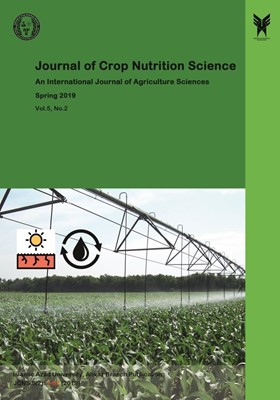Evaluation Impact of Different Irrigation Regime and Nitrogen Fertilizer on Qualitative Characteristics of Wheat
محورهای موضوعی : Journal of Crop Nutrition ScienceMorteza Mohamadi 1 , Kamran Mohsenifar 2 , Abdolali Gilani 3
1 - MSc. Graduated, Department of Soil Science, Khuzestan Science and Research Branch, Islamic Azad University, Ahvaz, Iran.|Department of Soil Science, Ahvaz Branch, Islamic Azad University, Ahvaz, Iran.
2 - Department of Soil Science, Ahvaz Branch, Islamic Azad University, Ahvaz, Iran.
3 - Assistant Professor of Seed and Plant Improvement Research Department, Khuzestan Agricultural and Natural Resources Research Center, AREEO, Ahvaz, Iran.
کلید واژه: Nutrition, phosphorus, Potassium, <i>Deficit irrigation, Protein</i>,
چکیده مقاله :
BACKGROUND: One of limitation factor in agricultural plants production in dry areas, supply requires water. Also nutrition crop management is a necessary strategy for achieve sustainable agriculture. OBJECTIVES: Current study was conducted to assessment the effects of different irrigation regimes and several amount of nitrogen fertilizer on seed nutrition content and qualitative trait of wheat. METHODS: This research was done via factorial experiment based on completely randomized design with three replications. The factors consisted different irrigation regime (I1=half of water demand, I2= equal of water demand and I3=1.5 water demand) and nitrogen fertilizer (N1=nonuse of nitrogen or control, N2=50%, N3=75% and N4=100% according soil test). RESULT: According result of analysis of variance effect of different level of nitrogen fertilizer, irrigation regime and interaction effect of treatments on all measured traits (instead phosphorus concentration) was significant at 1% probability level. Mean comparison result of different level of irrigation regime indicated that maximum nitrogen concentration was noted for half of water demand and minimum of that belonged to 1.5 water demand treatment, so increasing the volume of consumed water led to decrease the seed nitrogen concentration from 1.73 mg.kg-1 to 1.49 mg.kg-1. Nitrogen fertilizer increased nitrogen content from 1.2 in control to 2 mg.kg-1 in 100% according soil test treatment but does not have significant effect on phosphorus content also led to increase potassium content. CONCLUSION: Comparison of different irrigation treatments showed that increasing the volume of water decreased seed nitrogen content, increase potassium content and don’t have significant effect on phosphorus content. Also increasing consumed water led to decreased ease seed protein content. The maximum protein concentration (15%) was noted for half of water demand and 100% according soil test.
Adams, W. J., Blust, R., Borgmann, U., Brix, K. V., DeForest, D. K., Green, A. S., Mey-er, J.S., McGeer, J. C., Paquin, P. R. and Rainbow, P. S., 2011. Utility of tissue residues for predicting effects of metals on aquatic organisms. Integrated environmental assess-ment and management. 7: 75-98.
Aftab, W., A. Ghaffar, M. M. Khalid Hussain. and W. Nasim. 2007. Yield response of maize hydrides to varying nitrogen rates. Pak. J. Agri. Sci. 44(2): 217-220.
Bremner, J. M. and G. A. Breitenbeck. 1983. A simple method for determination of ammonium in semi micro Kjeldahl analysis of soils and plant materials using a block digester. Soil Sci. Plant Anal. 14: 905-913.
Cakir, R. 2004. Effect of water stress at different development stages on vegetative and reproductive growth of corn. Field Crops. J. 89: 1-16.
Cathcart, R. J. and C. J. Swanton. 2003. Nitrogen management will influence threshold values of green foxtail (Setaria viridis) in corn. Weed Sci. 51: 975-986.
English, M. J. and L. James. 1990. Deficit irrigation. II: Observation on colombia basin. ASCE, J. Irrigation Drain. Eng. 116: 413-426.
Gee, G. W. and J. W. Bauder. 1986. Methods of soil analysis: Part 1-Physical and mineralogical methods. Madison. WI: Soil Science Society of America. American Society of Agronomy.
Hossain, M. and V. P. Singh. 2000. Fertilizer use in Asian agriculture: implications for sustaining food security and the environment. Nutr. Cycl. Agro-Eco-Sys. J. 57: 155-169.
Ladha, K. J., H. Pathak, T. J. Krupnik, J. Six. and C. Van Kessel. 2005. Efficiency of fertilizer nitrogen in cereal production: Retrospect and prospects. J. Adv. Agron. 87: 85-156.
Maralian, R. 2008. Effect of zinc and iron foliar application on improving the quantitative and qualitative characteristics of three wheat cultivars. Journal of Agricultural Research (Water, Soil, Plant in Agriculture). 8(4): 47-59.
Maralian, H. 2012. Effect of Supplementary nutrition With Fe, Zn Chelates and urea on eheat quality and quantity. African Journal of Biotechnology. 11(11): 2661-2665.
Murdock, L., Jones, S. Bowley, C., Needham, P. James, J. and Howe. P. 1997. Using a chlorophyll meter to make nitrogen recommendations on wheat. Coop. Extension Service. Univ. Kentucky. College Agri. USA.
Sepaskhah, A. R. and M. H. Khajehabdollahi. 2005. Alternate furrow irrigation with different irrigation intervals for maize (Zea mays L.). Plant Production Science. J. 8(5): 592-600.
Shabankareh, M. G., H. Amanipoor, S. Battaleb-Looie. and J. D. Khatooni. 2018. Statistical modeling the effect of sediment physicochemical properties on the concentration of heavy metal (Case study: Musa Creek, SW Iran). J. Environmental Earth Sci. 77: 10-18.
Shah, Z., S. H. Shah, M. B. Peoples, G. D. Schwenke. and D. F. Herriedge. 2003. Crop residue and fertilizer N effects on nitrogen fixation and yields of legume nitrogen cereal rotations and soil organic fertility. Field Crops Res. 83: 1-11.
Singh, D. K., A. K. Pandey, U. B. Pandey. and S. R. Bhonde. 2002. Effect of farmyard manure combined with foliar application of NPK mixture and micronutrients on growth, yield and quality of Onion. Newsletter-Natl. Horti. Res. Develop. Found. 21-22: 1-7.
Souza, S. R., E. Mariam, L. M. Stark. and M. S. Fernandes. 1998. Nitrogen remobilization during the reproductive period in two Brazilian rice varieties. J. Plant Nutr. 21: 2049-2053.
Szulc, P. 2013. Effects of soil supplementation with urea and magnesium on nitrogen uptake, and utilization by two different forms of maize (Zea mays L.) differing in senescence rates. Polish J. Environ. Stud. 22: 239-248.
Verma, N. K. 2011. Integrated nutrient management in winter maize (Zea mays L.) sown at different dates. J. Plant Breed. Crop Sci. 3: 161-167.


